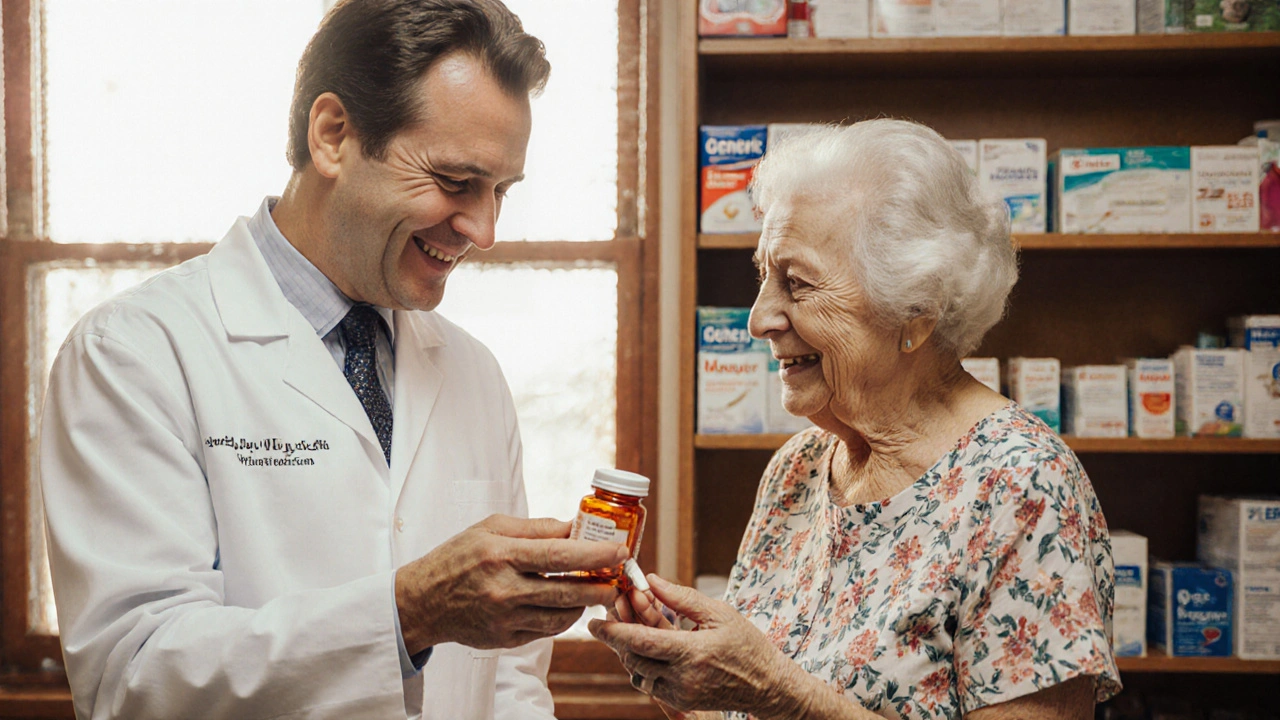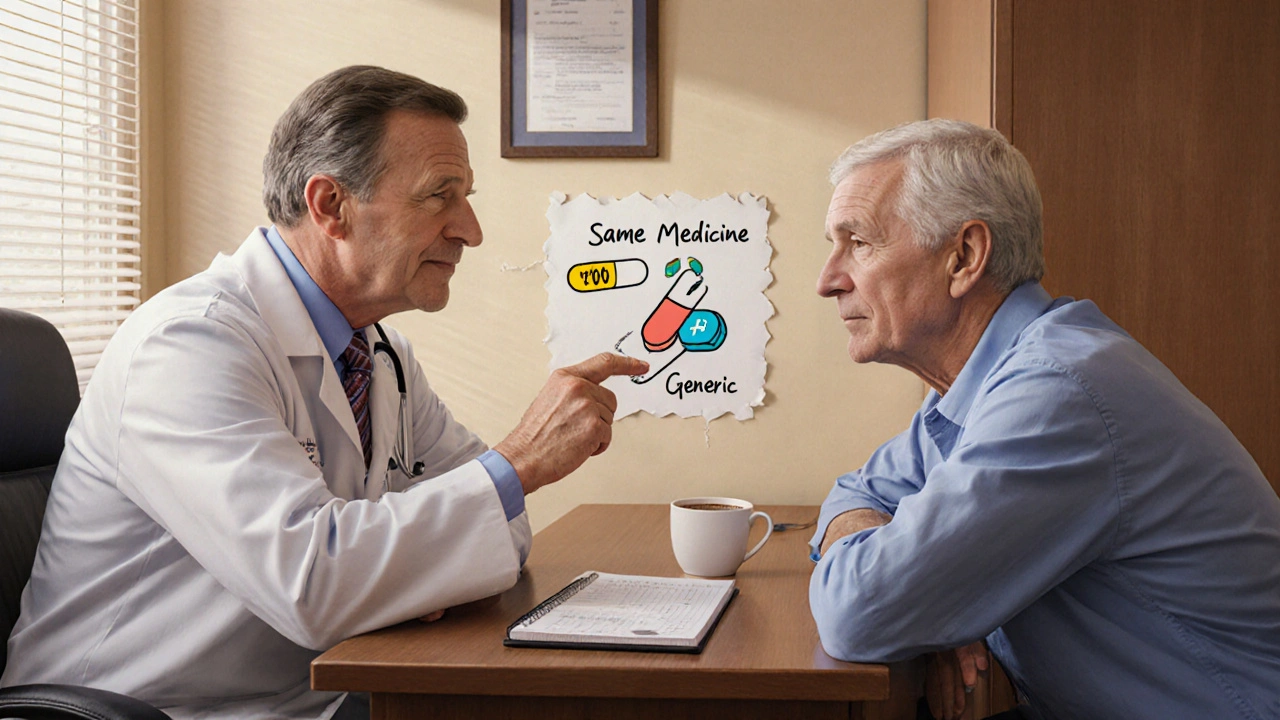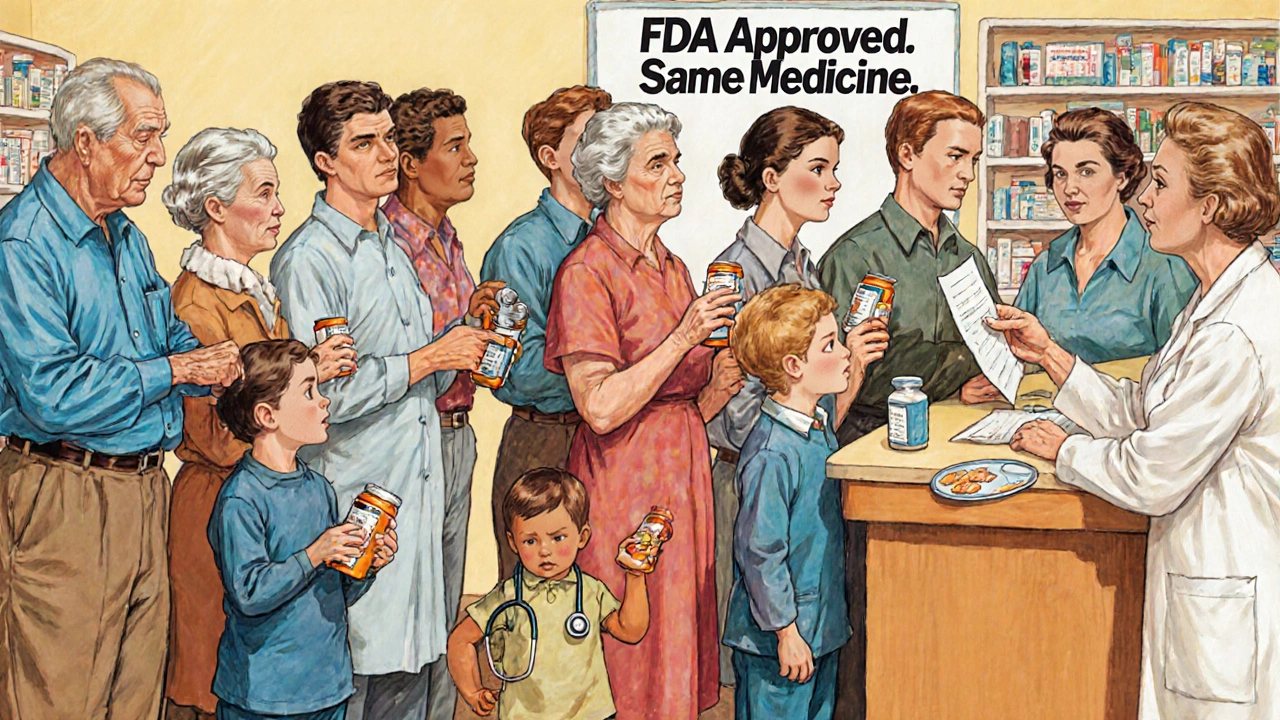How to Talk to Patients About Generic Medications Without Losing Their Trust

When a patient picks up a prescription and sees a pill that looks nothing like the one they’ve been taking for years, their first thought isn’t about cost savings-it’s is this really the same medicine? That moment of doubt can derail treatment, especially for chronic conditions like high blood pressure, diabetes, or thyroid disease. The truth? It’s almost always the same medicine. But if you don’t explain it clearly, patients will assume the worst.
Why Patients Doubt Generics
Most patients don’t know how generics are approved. They see a different color, shape, or size and assume it’s inferior. Some have had bad experiences-maybe a generic made them feel nauseous, or they thought it didn’t work as well. Those feelings are real, even if the science says otherwise. The FDA requires generic drugs to have the exact same active ingredient, strength, dosage form, and route of administration as the brand-name version. They must also prove bioequivalence: the amount of drug absorbed into the bloodstream must be within 80-125% of the brand. That’s not a guess-it’s a strict, science-backed standard. Yet, 28% of patients still worry about switching, and 17% stop taking their meds altogether after a switch, according to the Journal of General Internal Medicine. The real issue isn’t the drug. It’s the lack of clear communication. Patients hear "generic" and think "cheap substitute." They don’t hear "FDA-approved equivalent."The Cost Difference Is Real-And It Matters
Generics cost 80-85% less than brand-name drugs. In the U.S., they make up 90% of prescriptions but only 23% of total drug spending. That’s a $373 billion annual savings for the healthcare system. For a Medicare patient on Crestor, switching to rosuvastatin might mean dropping from $300 a month to $10. That’s not just a savings-it’s the difference between taking the medicine and skipping doses because they can’t afford it. Insurance plans know this. Eighty-four percent of health plans put generics in the lowest cost tier. Brand-name drugs? Only 12% get that same treatment. If a patient can’t afford their medicine, it doesn’t matter how good it is. They won’t take it.What Pharmacists Know That Doctors Often Don’t
Sixty-seven percent of patients get their information about generics from their pharmacist-not their doctor. That’s because pharmacists are the ones handing over the pill bottle. They see the confusion on the patient’s face. They hear the questions: "Why does this look different?" "Is it as strong?" "Will it work the same?" Doctors are busy. They write the script. But pharmacists have the time to explain. And they should. Research shows patients who get a clear explanation are 22% more likely to stick with their medication six months later.The TELL Framework: A Simple Way to Talk About Generics
There’s no need for jargon. No need to quote FDA guidelines. Just use the TELL method:- Tell them: "This generic has the same active ingredient as your brand-name drug. It’s not a different medicine-it’s the same one, just without the brand name."
- Explain: "The color and shape are different because of trademark laws. The inactive ingredients-like fillers or dyes-are changed so the manufacturer can’t copy the exact look. But those don’t affect how the medicine works."
- Listen: Don’t assume you know their concern. Ask: "What’s your biggest worry about this change?" Maybe they had a bad reaction before. Maybe they’re scared it won’t control their blood pressure. Let them say it.
- Link: Connect it to their life. "This change means you’ll save $290 a month. That’s enough for groceries, or to fill your gas tank, or to pay for your grandson’s school trip. And you’ll still get the same protection from your heart disease."

Addressing the Most Common Questions
Patients ask the same things over and over. Have your answers ready.- "Is this really the same medicine?" Yes. Same active ingredient. Same strength. Same way it works in your body. The FDA checks this before it’s sold.
- "Why does it look different?" By law, generics can’t look exactly like the brand. It’s a trademark rule. Think of it like two different brands of aspirin-they all have the same painkiller, but one is red, one is white.
- "Is it as strong?" Yes. The FDA requires it to deliver the same amount of medicine into your bloodstream. If it didn’t, it wouldn’t be approved.
- "I tried it and it didn’t work." That’s often about expectations, not the drug. Sometimes the placebo effect fades when the pill looks different. Sometimes the patient switched between two different generics, and the fillers affected them. But if they’re truly not responding, it’s not because it’s generic-it’s because the dose might need adjusting, or another issue is at play.
When Generics Might Need Extra Care
There are exceptions. Drugs with a narrow therapeutic index-like warfarin, levothyroxine, or phenytoin-require very precise blood levels. Small changes can matter. That’s why the FDA requires extra scrutiny for these drugs. In these cases, it’s best to stick with one manufacturer. If a patient has been stable on a particular generic, don’t switch them to another unless necessary. If they’re on brand-name and you’re switching to generic, document the brand and generic used. Monitor closely for the first few weeks. But here’s the key: all FDA-approved generics for these drugs meet the same standard. The issue isn’t the generic-it’s frequent switching between multiple manufacturers. That’s why many patients report side effects: they’re not on the same version consistently.What Works: Real Stories
A 68-year-old woman with high cholesterol was spending $320 a month on Lipitor. After switching to atorvastatin, her copay dropped to $12. She was angry at first-"This pill is smaller and white. It doesn’t feel right." Her pharmacist spent five minutes explaining the FDA standards, showed her the active ingredient label, and said, "You’re still getting the same medicine. You’re just keeping more money in your pocket." Six months later, she told her doctor, "I’ve never felt better. And I haven’t missed a pill since." Another patient, a veteran on fixed income, stopped taking his blood pressure med because the brand was too expensive. He started having chest pains. His pharmacist switched him to a generic, explained it simply, and helped him enroll in a discount program. His blood pressure normalized in three weeks.
What Doesn’t Work: Assumptions and Rushing
Don’t say: "It’s the same thing. Don’t worry about it." That dismisses their fear. Don’t assume they understand terms like "bioequivalence" or "inactive ingredients." Use plain language. Don’t skip the conversation because you’re in a hurry. A five-minute talk now can prevent a hospital visit later.Training and Tools That Help
Pharmacists who complete the American Pharmacists Association’s "Communicating with Patients about Generics" course report 65% more confidence in these conversations. They use the teach-back method: "Can you tell me in your own words why this generic is safe?" That boosts retention by 40%. The FDA is now funding video tools to help. One pilot showed that showing a 90-second animated video before the conversation increased patient acceptance by 31% compared to talking alone.The Bigger Picture
Generics aren’t just about saving money. They’re about access. They’re about people with diabetes taking their insulin. People with hypertension keeping their blood pressure under control. People with depression staying on their meds because they can afford it. The system works-when we explain it. The science is solid. The savings are massive. The only thing missing is the conversation. If you’re a provider, don’t hand over a script and walk away. Don’t assume the pharmacist will handle it. Ask: "Have you talked to them about the generic?" If they haven’t, do it yourself. If you’re a pharmacist, don’t wait for them to ask. Start the conversation. Use TELL. Listen. Link it to their life. Because the medicine works. But only if they take it.Are generic medications as safe as brand-name drugs?
Yes. The FDA requires generics to meet the same strict safety and quality standards as brand-name drugs. They must contain the same active ingredient, strength, and dosage form, and they must be bioequivalent-meaning they work the same way in the body. All generic manufacturers are inspected just like brand-name companies, and their facilities are held to the same standards.
Why do generic pills look different from brand-name ones?
By U.S. law, generic drugs can’t look exactly like the brand-name version because of trademark rules. The shape, color, or markings may differ, but the active ingredient is identical. The differences are only in inactive ingredients like dyes or fillers, which don’t affect how the drug works. These changes are made so generic manufacturers can’t copy the brand’s appearance.
Can switching to a generic cause side effects?
Rarely. Side effects from switching are usually due to differences in inactive ingredients-like lactose or dyes-that some people are sensitive to. If a patient reports new symptoms after switching, it’s worth checking if they’ve changed manufacturers. For drugs with a narrow therapeutic index-like thyroid medicine or blood thinners-sticking with one generic version is often best to avoid variability.
Do generics take longer to work than brand-name drugs?
No. The FDA requires generics to be absorbed into the bloodstream at the same rate and to the same extent as the brand-name version. Studies show no meaningful difference in how quickly they start working. If a patient feels it’s slower, it’s likely due to expectation, not science.
Why do some patients say generics don’t work as well?
This often comes from the placebo effect or inconsistent switching between different generic manufacturers. When patients expect a change, they may notice differences that aren’t real. Also, if someone switches from one generic to another-say, from one company’s rosuvastatin to another’s-the fillers might affect them differently. But when compared to the original brand, generics perform just as well in clinical studies.
Should I avoid generics for chronic conditions like high blood pressure or diabetes?
No. In fact, generics are ideal for chronic conditions because they make long-term treatment affordable. Studies show patients on generics for conditions like hypertension and diabetes are more likely to stick with their treatment because they can afford it. The key is consistency-stick with one generic manufacturer if possible, especially for drugs with narrow therapeutic windows.
What are authorized generics?
Authorized generics are brand-name drugs sold under a generic label, made by the original manufacturer. They’re identical to the brand in every way, including appearance, but cost less because they’re sold without the brand name. These are a good option for patients who are skeptical of generics but need to save money.